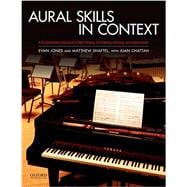Aural Skills in Context takes a comprehensive approach to sight singing, ear training, and rhythm practice. By featuring real examples from classical music to folk and jazz, and offering melodies with their related harmonies, the text parallels the full Music Theory curriculum and reinforces the relevance of aural skills to students' other classes, as well as their performance and listening interests. In addition to a wide variety of partial and complete excerpts, Aural Skills in Context also provides a wealth of activities that range far beyond simply singing the melodies or writing them down from dictation, giving instructors and students the opportunity to engage in improvisation; performance in multiple voices; switching between melody and accompanying lines; creating new melodies above a given bass line; or even an additional "obbligato" voice above the given melody or between the outer voices.
* Rhythmic, harmonic, and melodic drills accompany musical examples and solidify students' understanding of the position of every pitch within the tonal context
* "Expanding Repertoires" sections include listening and dictation-type exercises that allow students to engage in listening beyond the traditional examples
* "Contextual Listening" assignments are accompanied with streaming audio at various tempos and an online mixer for balancing musical parts on the companion website, www.oup.com/us/jonesshaftel
* Designed so that it may be used with Finale Smartmusic, an inexpensive software program that enables students to receive immediate feedback on their sight singing, while keeping a record of their progress.








